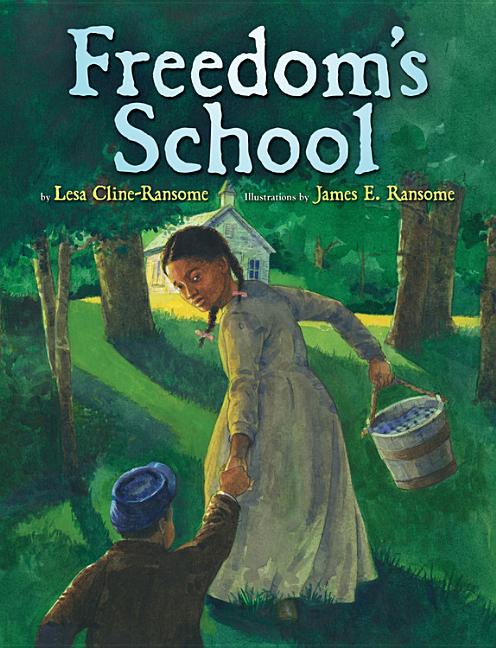Book Descriptions
for Freedom's School by Lesa Cline-Ransome and James Ransome
From Cooperative Children's Book Center (CCBC)
This portrait of a fictional community’s efforts to establish a school for African American children begins on the title page with an illustration of the newly arrived teacher and a newspaper beside her on the bench with the headline “Thirteenth Amendment Ends Slavery.” Lizzie and Paul’s Mama tells them that “bein’ free means we got to work harder than ever before. And I don’t just mean in the field. Real freedom means ’rithmetic and writing.” After the children start attending a one-room school house where classes are taught by an African American woman, they face some obstacles, including harassment from white boys during the walk to school. But the real challenge comes when the school is burned down. Paul and Lizzie try to continue practicing their reading and writing at home. When the weather gets warmer, Mizz Howard teaches outside, on the site of the burned-down school. In the background, the children can see and hear a new school being built.The dramatic story is told through Lizzie’s distinctive voice, while the pencil and watercolor illustrations add historical detail. (Ages 5–10)
CCBC Choices 2016. © Cooperative Children's Book Center, Univ. of Wisconsin - Madison, 2016. Used with permission.
From the Publisher
When Lizzie's parents are granted their freedom from slavery, Mama says its time for Lizzie and her brother Paul to go to a real school -- a new one, built just for them. Lizzie can't wait. The scraps of learning she has picked up here and there have just made her hungry for more.
The walk to school is long. Some days it's rainy, or windy, or freezing cold. Sometimes there are dangers lurking along the way, like angry white folks with rocks, or mysterious men on horseback. The schoolhouse is still unpainted, and its very plain, but Lizzie has never seen a prettier sight. Except for maybe the teacher, Mizz Howard, who has brown skin, just like her.
They've finally made it to Freedom's School. But will it be strong enough to stand forever?
Praise for Light in the Darkness
"In this tale, [Cline-Ransome] makes the point that learning was not just a dream of a few famous and accomplished men and women, but one that belonged to ordinary folk willing to risk their lives. Ransome's full-page watercolor paintings-in beautiful shades of blue for the night and yellow for the day-are a window, albeit somewhat gentle, into a slave's life for younger readers. A compelling story about those willing to risk "[a] lash for each letter." -- Kirkus Reviews
"Told from the perspective of Rosa, a girl who makes the dangerous nighttime journey to the lessons with her mother, the story effectively conveys the urgent dedication of the characters to their surreptitious schooling and their belief in the power of literacy . . .Solid text and soft, skillful illustrations combine for a poignant tribute to the power of education and the human spirit." -- School Library Journal
The walk to school is long. Some days it's rainy, or windy, or freezing cold. Sometimes there are dangers lurking along the way, like angry white folks with rocks, or mysterious men on horseback. The schoolhouse is still unpainted, and its very plain, but Lizzie has never seen a prettier sight. Except for maybe the teacher, Mizz Howard, who has brown skin, just like her.
They've finally made it to Freedom's School. But will it be strong enough to stand forever?
Praise for Light in the Darkness
"In this tale, [Cline-Ransome] makes the point that learning was not just a dream of a few famous and accomplished men and women, but one that belonged to ordinary folk willing to risk their lives. Ransome's full-page watercolor paintings-in beautiful shades of blue for the night and yellow for the day-are a window, albeit somewhat gentle, into a slave's life for younger readers. A compelling story about those willing to risk "[a] lash for each letter." -- Kirkus Reviews
"Told from the perspective of Rosa, a girl who makes the dangerous nighttime journey to the lessons with her mother, the story effectively conveys the urgent dedication of the characters to their surreptitious schooling and their belief in the power of literacy . . .Solid text and soft, skillful illustrations combine for a poignant tribute to the power of education and the human spirit." -- School Library Journal
Publisher description retrieved from Google Books.


